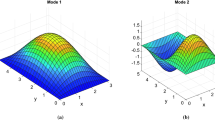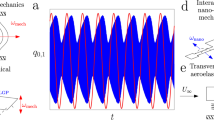Abstract
Stable normal-mode vibrations in engineering can be undesirable and one of the possibilities for quenching these is by embedding the oscillator in an autoparametric system by coupling to a damped oscillator. There exists the possibility of destabilizing the undesirable vibrations by a suitable tuning and choice of nonlinear coupling parameters. An additional feature is that, to make the quenching effective in the case of relaxation oscillations, one also has to deform the slow manifold by choosing appropriate coupling; this is illustrated for Rayleigh and van der Pol relaxation.
Similar content being viewed by others
References
Tondl A., Ruijgrok T., Verhulst F. and Nabergoj R. (2000). Autoparametric Resonance in Mechanical Systems. Cambridge University Press, New York Cambridge, 196 pp
Schmidt G. and Tondl A. (1986). Non-linear Vibrations. Akademie-Verlag, Berlin, 420 pp
Cartmell M. (1990). Introduction to Linear, Parametric and Nonlinear Vibrations. Chapman & Hall, London
Verhulst F. and Abadi (2005). Autoparametric resonance of relaxation oscilations. ZAMM 85: 122–131
Verhulst F. (2000). Nonlinear Differential Equations and Dynamical Systems. Springer-Verlag, New York 304 pp
Abadi (2001). On self-excited auto-parametric systems. Nonlinear Dynamics 24: 147–166
Grasman J. (1987). Asymptotic Methods for Relaxation Oscillations and Applications. Springer-Verlag, New York, 222 pp
T.J. Kaper, An introduction to geometric methods and dynamical systems theory for singular perturbation problems. In: J. C. and R. E. O’Malley, Jr. (eds.), Analyzing Multiscale Phenomena Using Singular Perturbation Methods. Proc. Symposia Appl. Math, AMS 56 (1999) pp. 85–131.
Verhulst F. (2005). Methods and applications of singular perturbations, boundary layers and multiple timescale dyanmics. Springer-Verlag, Berlin, 340 pp
Fenichel N. (1971). Persistence and smoothness of invariant manifolds for flows. Indiana Univ. Math. J. 21: 193–225
Fenichel N. (1974). Asymptotic stability with rate conditions. Indiana Univ. Math. J. 23: 1109–1137
Fenichel N. (1977). Asymptotic stability with rate conditions, II. Indiana Univ. Math. J. 26: 81–93
Fenichel N. (1979). Geometric singular perturbations theory for ordinary differential equations. J. Diff. Eq. 31: 53–98
Jones C.K.R.T. (1994). Geometric singular perturbation theory. In: Johnson R. (eds) Dynamical Systems. Montecatini Terme, Lecture Notes in Mathematics 1609. Springer-Verlag, Berlin, pp. 44–118
Author information
Authors and Affiliations
Corresponding author
Rights and permissions
About this article
Cite this article
Verhulst, F. Quenching of self-excited vibrations. J Eng Math 53, 349–358 (2005). https://doi.org/10.1007/s10665-005-9008-z
Received:
Accepted:
Published:
Issue Date:
DOI: https://doi.org/10.1007/s10665-005-9008-z




